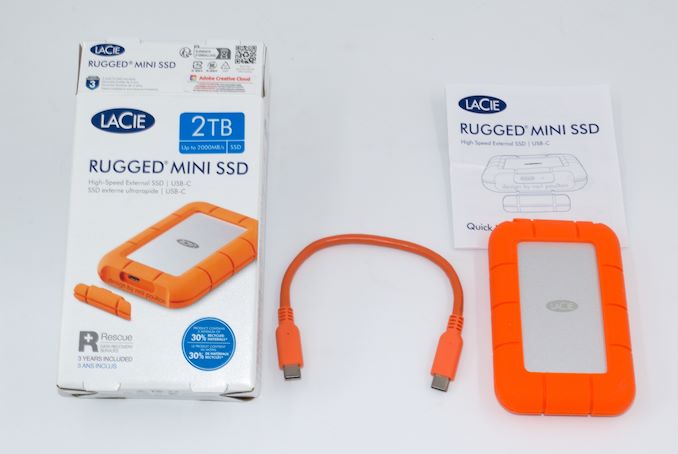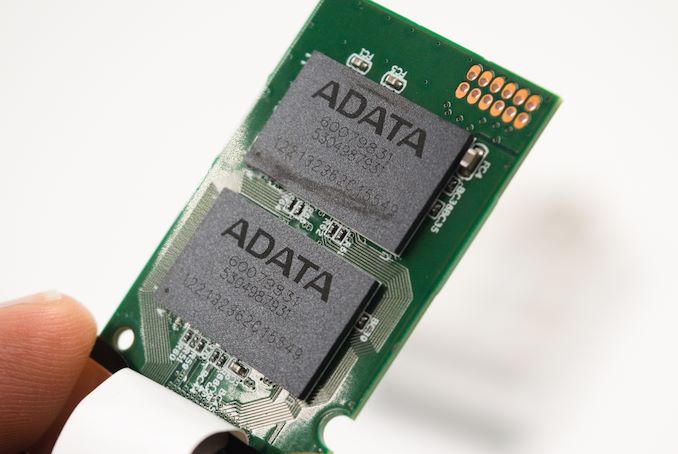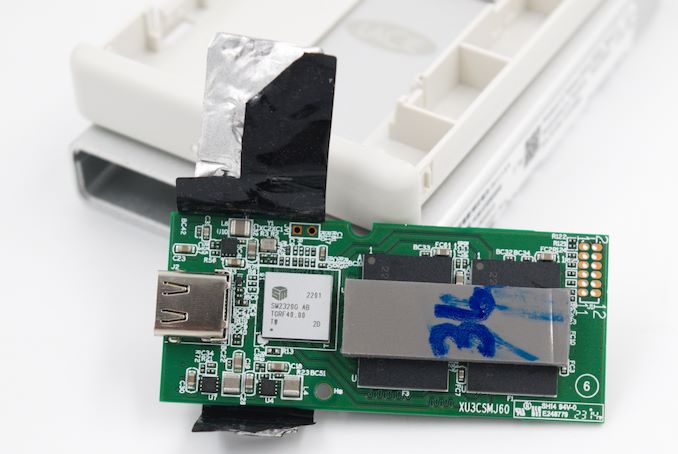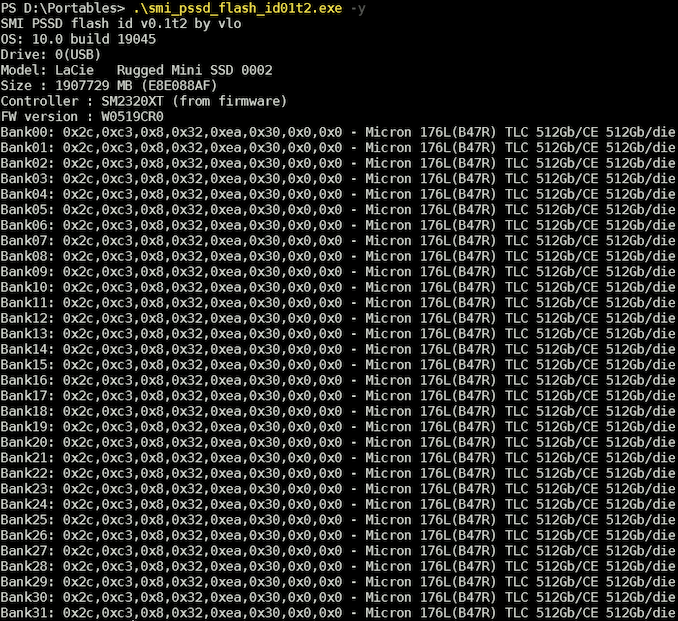LaCie Rugged Mini SSD Review: Power-Efficient Flash Storage at 20 Gbps
by Ganesh T S on January 3, 2024 8:00 AM EST- Posted in
- Storage
- SSDs
- Seagate
- Micron
- LaCie
- DAS
- Silicon Motion
- Portable SSDs

LaCie's portable storage drives have enjoyed a loyal consumer base, particularly among creative professionals valuing both performance and product design / appearance. After Seagate's acquisition, the brand has continued to cater to this segment with new products. The company has both USB 3.2 Gen 2 and Thunderbolt 3 SSDs under the LaCie brand, and is adding a new 2 GBps-class Rugged Mini SSD today.
The USB 3.2 Gen 2x2 (20 Gbps) ecosystem has been gaining traction recently after the launch of a number of low-cost portable SSDs based on native controllers. The new LaCie Rugged Mini SSD belongs to the same category, albeit with a slight premium for the product design and branding. The PSSD is available in four capacities - 500GB, 1TB, 2TB, and 4TB. The company sampled the 2TB version to put through our direct-attached storage test suite.
This review provides a comprehensive look at the performance profile and value proposition of the LaCie Rugged Mini SSD, with a particular focus on how Seagate differentiates the product from others using the same NAND / UFD controller combination.
Introduction and Product Impressions
External bus-powered storage devices have seen a growth in storage capacity and increase in speeds over the last decade. This has been due to advancements in flash technology (including the advent of 3D NAND and NVMe) and the evolution of faster host interfaces (such as Thunderbolt 3 and USB 3.x). As a result, we have been seeing palm-sized flash-based storage devices capable of delivering 3GBps+ speeds. While those speeds can be achieved with Thunderbolt 4, mass-market devices have to rely on USB. Within the USB ecosystem, USB 3.2 Gen 2 (10 Gbps) is fast becoming the entry level for thumb drives and portable SSDs. USB 3.2 Gen 2x2 (20 Gbps) got off to a slow start, but recent computing platforms from both Intel and AMD have started to support it on the host side. The introduction of native USB 3.2 Gen 2x2 flash controllers such as the Phison U18 and Silicon Motion SM2320 has enabled PSSD vendors to bring low-cost power-efficient 20 Gbps external drives to the market.
Broadly speaking, there are currently five distinct performance levels in the PSSD market:
- 2GBps+ drives with Thunderbolt 3 or USB4, using NVMe SSDs
- 2GBps drives with USB 3.2 Gen 2x2, using NVMe SSDs or direct USB flash drive (UFD) controllers
- 1GBps drives with USB 3.2 Gen 2, using NVMe SSDs or direct UFD controllers
- 500MBps drives with USB 3.2 Gen 1 (or, Gen 2, in some cases), using SATA SSDs
- Sub-400MBps drives with USB 3.2 Gen 1, using UFD controllers
Within each of these levels, there is further segmentation into entry-level, mid-range, and premium based on the choice of internal components. The LaCie Rugged Mini SSD 2 TB we are looking at today belongs to the second category in the above list. Seagate is marketing this as an environment-friendly drive, and almost all of the package contents are recyclable / made of post-recycled content. The box comes with the main unit, a quick-start guide, and a 20 Gbps / 240W Type-C cable to connect the PSSD to the host.
The Rugged Mini SSD includes the traditional orange-colored rubber bumper around a metal enclosure with plastic end-caps. This enables an IP54 rating and a bit of ruggedness (ability to withstand 3m falls, and handle a car being driven over it). Disassembling the unit was actually quite trivial. The rubber bumper can be easily slid off, and the plastic end-caps clamp against the inner side of the metal enclosure with plastic tabs. This can be easily unclasped using a thin flat-head screwdriver. The PSSD is internally held in place by a plastic contraption, again with notches to keep the board secure and tight. The board is quite small compared to the size of the plastic frame, as shown in the gallery below.
The 2TB drive is double-sided, with four flash packages (two on each side). There are thick thermal pads on top of them. The flash packages are from ADATA.
There is no decoder available for the markings on the ADATA package, but we get a pointer from the controller on the board - the Silicon Motion SM2320, which is under its own compact thermal wrapper.
The Silicon Motion controllers fortunately have a flash identifier tool available, and processing the LaCie Rugged Mini SSD through it reveals the presence of Micron's B47R NAND (176L 3D TLC) inside the ADATA packages.
This review compares the LaCie Rugged Mini SSD against a host of other 2GBps-class PSSDs we have reviewed before. An overview of the internal capabilities of these PSSDs is given by CrystalDiskInfo. The LaCie Rugged Mini supports full S.M.A.R.T passthrough, along with TRIM to ensure consistent performance for the drive over its lifetime. However, some of the parameters read out (such as the total NAND writes, and a lifespan of less than 100% when fresh out of the box) seem suspect, and we believe some firmware fixes are in order for this.
| S.M.A.R.T Passthrough - CrystalDiskInfo | |
 |
 |
The table below presents a comparative view of the specifications of the different PSSDs presented in this review.
| Comparative Direct-Attached Storage Devices Configuration | ||
| Aspect | ||
| Downstream Port | Native Flash | Native Flash |
| Upstream Port | USB 3.2 Gen 2x2 Type-C (Female) | USB 3.2 Gen 2x2 Type-C (Female) |
| Bridge Chip | Silicon Motion SM2320 | Silicon Motion SM2320 |
| Power | Bus Powered | Bus Powered |
| Use Case | 2GBps-class, IP54-rated palm-sized high-performance portable SSD with a Type-C interface | 2GBps-class, sturdy palm-sized high-performance portable SSD with a Type-C interface |
| Physical Dimensions | 90 mm x 58 mm x 12 mm (without bumper) 105 mm x 66 mm x 16 mm (with bumper) |
65 mm x 50 mm x 10 mm |
| Weight | 100 grams | 42 grams |
| Cable | 21 cm USB 3.2 Gen 2x2 Type-C (male) to Type-C (male) | 22 cm USB 3.2 Gen 2x2 Type-C (male) to Type-C (male) |
| S.M.A.R.T Passthrough | Yes | Yes |
| UASP Support | Yes | Yes |
| TRIM Passthrough | Yes | Yes |
| Hardware Encryption | No | Yes |
| Evaluated Storage | Micron B47R 176L 3D TLC (packaged by ADATA) | Micron B47R 176L 3D TLC |
| Price | $190 | $169 |
| Review Link | Crucial X10 Pro 2TB Review | Crucial X10 Pro 2TB Review |
Based on the details in the above table, it is evident that the interesting toss up is between the LaCie Rugged Mini and the Crucial X10 Pro - they use the same UFD controller / NAND combination, and the performance differences should boil down to the firmware configuration and thermal solution effectiveness.
Prior to looking at the benchmark numbers, power consumption, and thermal solution effectiveness, a description of the testbed setup and evaluation methodology is provided.
Testbed Setup and Evaluation Methodology
Direct-attached storage devices (including portable SSDs) are evaluated using the Quartz Canyon NUC (essentially, the Xeon / ECC version of the Ghost Canyon NUC) configured with 2x 16GB DDR4-2667 ECC SODIMMs and a PCIe 3.0 x4 NVMe SSD - the IM2P33E8 1TB from ADATA.
The most attractive aspect of the Quartz Canyon NUC is the presence of two PCIe slots (electrically, x16 and x4) for add-in cards. In the absence of a discrete GPU - for which there is no need in a DAS testbed - both slots are available. In fact, we also added a spare SanDisk Extreme PRO M.2 NVMe SSD to the CPU direct-attached M.2 22110 slot in the baseboard in order to avoid DMI bottlenecks when evaluating Thunderbolt 3 devices. This still allows for two add-in cards operating at x8 (x16 electrical) and x4 (x4 electrical). Since the Quartz Canyon NUC doesn't have a native USB 3.2 Gen 2x2 port, Silverstone's SST-ECU06 add-in card was installed in the x4 slot. All non-Thunderbolt devices are tested using the Type-C port enabled by the SST-ECU06.
The specifications of the testbed are summarized in the table below:
| The 2021 AnandTech DAS Testbed Configuration | |
| System | Intel Quartz Canyon NUC9vXQNX |
| CPU | Intel Xeon E-2286M |
| Memory | ADATA Industrial AD4B3200716G22 32 GB (2x 16GB) DDR4-3200 ECC @ 22-22-22-52 |
| OS Drive | ADATA Industrial IM2P33E8 NVMe 1TB |
| Secondary Drive | SanDisk Extreme PRO M.2 NVMe 3D SSD 1TB |
| Add-on Card | SilverStone Tek SST-ECU06 USB 3.2 Gen 2x2 Type-C Host |
| OS | Windows 10 Enterprise x64 (21H1) |
| Thanks to ADATA, Intel, and SilverStone Tek for the build components | |
The testbed hardware is only one segment of the evaluation. Over the last few years, the typical direct-attached storage workloads for memory cards have also evolved. High bit-rate 4K videos at 60fps have become quite common, and 8K videos are starting to make an appearance. Game install sizes have also grown steadily even in portable game consoles, thanks to high resolution textures and artwork. Keeping these in mind, our evaluation scheme for direct-attached storage devices involves multiple workloads which are described in detail in the corresponding sections.
- Synthetic workloads using CrystalDiskMark and ATTO
- Real-world access traces using PCMark 10's storage benchmark
- Custom robocopy workloads reflective of typical DAS usage
- Sequential write stress test
In the next section, we have an overview of the performance of the LaCie Rugged Mini SSD in these benchmarks. Prior to providing concluding remarks, we have some observations on the PSSD's power consumption numbers and thermal solution also.





















8 Comments
View All Comments
VinceVDC - Wednesday, January 3, 2024 - link
I bought my first LaCie drive in 1987. It was a 100mb SCSI drive and cost $1100. The thing still works but is pretty much useless due to its size.ballsystemlord - Wednesday, January 3, 2024 - link
Can you upload a picture and post a link here? That'd be cool to see!VinceVDC - Friday, January 5, 2024 - link
It was part of my "this is what computers used to look like" display when I had lots of room at home.Let me see if I can find it after the move (downsized).. Sooo many boxes, lol
The Mac SE it was attached to failed the smoke test a couple years ago.
Picture a 5-1/4 inch external CD drive with a 25 pin SCSI connector.
I bought it in 1987 from the LaCie office in Tigard, OR.
Da Kat - Thursday, January 4, 2024 - link
As big as a Kia, I'd bet..Mehere88 - Tuesday, January 9, 2024 - link
Why tout a 20Gbps connection for a device that can't go past 2.8 Gbps?mikato - Friday, January 19, 2024 - link
Why have an orange bumper around it for a device that isn't sensitive to physical shock damage?Chrestos SV1GAP - Thursday, February 8, 2024 - link
There is a (minor) error:"Review Link Crucial X10 Pro 2TB Review Crucial X10 Pro 2TB Review"
J.in.Tech - Friday, February 16, 2024 - link
As someone who has purchased Lacie drives on and off over the years, and literally all of them failing, I am weary of the brand regardless of them now being owned by Seagate.